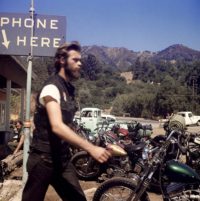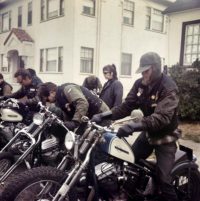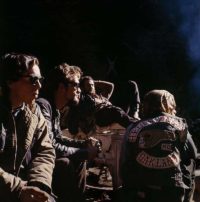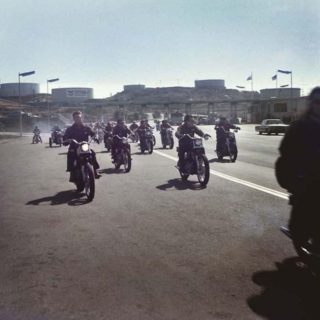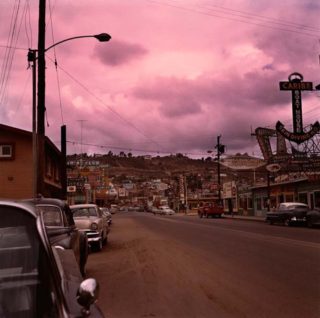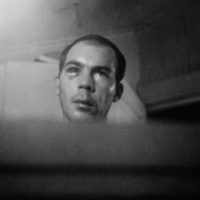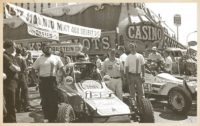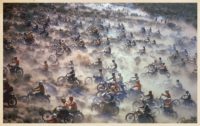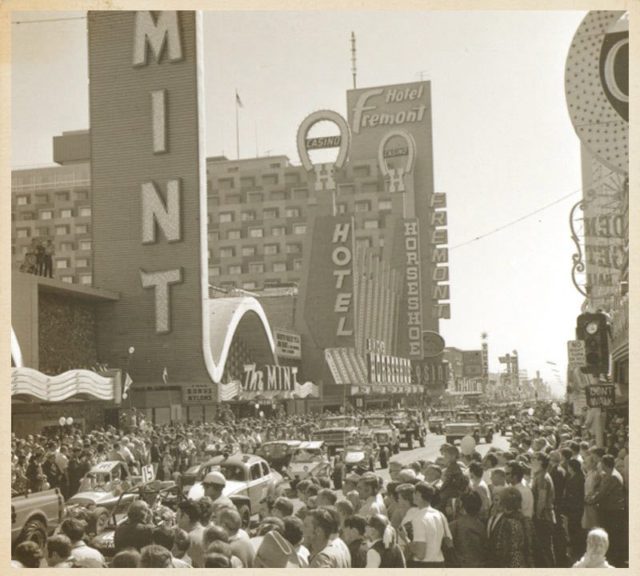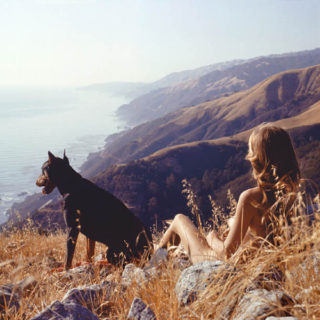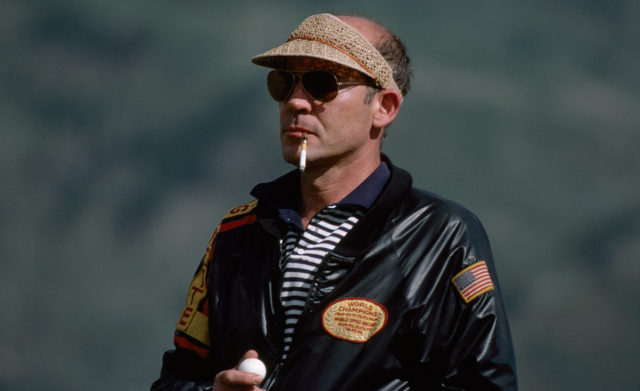
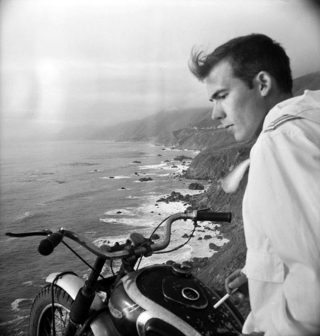 To quote the esteemed Mr. Paul d’Orléans of the Vintagent; “I can imagine few journalists working outside of motorcycle-industry ‘rags’, who have been as intimately connected to motorcycling as Hunter S. Thompson.”
To quote the esteemed Mr. Paul d’Orléans of the Vintagent; “I can imagine few journalists working outside of motorcycle-industry ‘rags’, who have been as intimately connected to motorcycling as Hunter S. Thompson.”
Starting in his teens with a stripped-down 1948 Triumph, Thompson owned or “borrowed” a variety of bikes throughout his life: a life that he himself often referred to as “the wild ride”.
In 1965 Hunter Thompson was living in San Francisco. He had recently quit the National Observer and was dead broke. The editor of The Nation asked him to write a story about the Hell’s Angels Motorcycle Club. The article quickly led to a book deal, and, the next year, the Gonzo journalist published Hell’s Angels: The Strange and Terrible Saga of the Outlaw Motorcycle Gangs.
Reviewing the book for The New York Times, Leo Litwak wrote: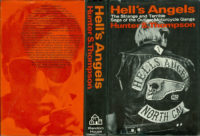
“Hunter Thompson entered this terra incognita [the world of the Hell’s Angels] to become its cartographer. For almost a year, he accompanied the Hell’s Angels on their rallies. He drank at their bars, exchanged home visits, recorded their brutalities, viewed their sexual caprices, became converted to their motorcycle mystique, and was so intrigued, as he puts it, that “I was no longer sure whether I was doing research on the Hell’s Angels or being slowly absorbed by them.” At the conclusion of his year’s tenure the ambiguity of his position was ended when a group of Angels knocked him to the ground and stomped him…
Hunter Thompson has presented us with a close view of a world most of us would never dare encounter, yet one with which we should be familiar. He has brought on stage men who have lost all options and are not reconciled to the loss. They have great resources for violence which doesn’t as yet have any effective focus. Thompson suggests that these few Angels are but the vanguard of a growing army of dis-appropriated, disaffiliated and desperate men. There’s always the risk that somehow they may force the wrong options into being.”
Hunter S. Thompson meets a Hell’s Angel, 1967: CBC Archives
“Last Labor Day weekend newspapers all over California gave front-page reports of a heinous gang rape in the moonlit sand dunes near the town of Seaside on the Monterey Peninsula. Two girls, aged 14 and 15, were allegedly taken from their dates by a gang of filthy, frenzied, boozed-up motorcycle hoodlums called “Hell’s Angels,” and dragged off to be “repeatedly assaulted.”
A deputy sheriff, summoned by one of the erstwhile dates, said he “arrived at the beach and saw a huge bonfire surrounded by cyclists of both sexes. Then the two sobbing, near-hysterical girls staggered out of the darkness, begging for help. One was completely nude and the other had on only a torn sweater.”
Some 300 Hell’s Angels were gathered in the Seaside-Monterey area at the time, having convened, they said, for the purpose of raising funds among themselves to send the body of a former member, killed in an accident, back to his mother in North Carolina. One of the Angels, hip enough to falsely identify himself as “Frenchy of San Bernardino,” told a reporter who came out to meet the cyclists: “We chose Monterey because we get treated good here; most other places we get thrown out of town.”
But Frenchy spoke too soon. The Angels weren’t on the peninsula twenty-four hours before four of them were in jail for rape, and the rest of the troop was being escorted to the county line by a large police contingent. Several were quoted, somewhat derisively, as saying: “That rape charge against our guys is phony and it won’t stick.”
It turned out to be true, but that was another story and certainly no headliner. The difference between the Hell’s Angels in the paper and the Hell’s Angels for real is enough to make a man wonder what newsprint is for. It also raises a question as to who are the real hell’s angels.
Ever since World War II, California has been strangely plagued by wild men on motorcycles. They usually travel in groups of ten to thirty, booming along the highways and stopping here are there to get drunk and raise hell. In 1947, hundreds of them ran amok in the town of Hollister, an hour’s fast drive south of San Francisco, and got enough press to inspire a film called The Wild One, starring Marlon Brando. The film had a massive effect on thousands of young California motorcycle buffs; in many ways, it was their version of The Sun Also Rises.
The California climate is perfect for motorcycles, as well as surfboards, swimming pools and convertibles. Most of the cyclists are harmless weekend types, members of the American Motorcycle Association, and no more dangerous than skiers or skin divers. But a few belong to what the others call “outlaw clubs,” and these are the ones who–especially on weekends and holidays–are likely to turn up almost anywhere in the state, looking for action. Despite everything the psychiatrists and Freudian casuists have to say about them, they are tough, mean and potentially as dangerous as a pack of wild boar. When push comes to shove, any leather fetishes or inadequacy feelings that may be involved are entirely beside the point, as anyone who has ever tangled with these boys will sadly testify. When you get in an argument with a group of outlaw motorcyclists, you can generally count your chances of emerging unmaimed by the number of heavy-handed allies you can muster in the time it takes to smash a beer bottle. In this league, sportsmanship is for old liberals and young fools. “I smashed his face,” one of them said to me of a man he’d never seen until the swinging started. “He got wise. He called me a punk. He must have been stupid.””
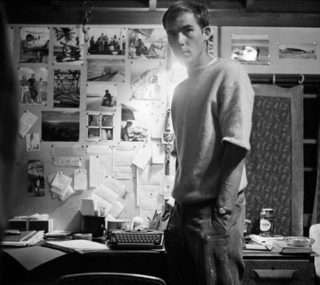 “The Hell’s Angels as they exist today were virtually created by Time, Newsweek, and The New York Times. The Times is the heavyweight champion of American journalism. On nine stories out of ten the paper lives up to its reputation. Yet the editors make no claim to infallibility, and now and then they will blow the whole duke. It would be senseless to try to list these failures, and besides that the purpose of this harangue is not to nail any one newspaper or magazine – but to point out the potentially massive effect of any story whose basic structure is endorsed and disseminated not only by Time, and Newsweek, but by the hyper-prestigious New York Times.
“The Hell’s Angels as they exist today were virtually created by Time, Newsweek, and The New York Times. The Times is the heavyweight champion of American journalism. On nine stories out of ten the paper lives up to its reputation. Yet the editors make no claim to infallibility, and now and then they will blow the whole duke. It would be senseless to try to list these failures, and besides that the purpose of this harangue is not to nail any one newspaper or magazine – but to point out the potentially massive effect of any story whose basic structure is endorsed and disseminated not only by Time, and Newsweek, but by the hyper-prestigious New York Times.
The Times took the Lynch report [the pseudo-objective and vague report of an investigation mounted by California’s ambitious new Attorney General Thomas C. Lynch, concerning Hell’s Angels and “other disreputables”] at face value and simply reprinted it in very condensed form. The headline said: CALIFORNIA TAKES STEPS TO CURB TERRORISM OF RUFFIAN CYCLISTS. The bulk of the article was straight enough, but the lead was pure fiction: “A hinterland tavern is invaded by a group of motorcycle hoodlums. They seize a female patron and rape her. Departing, they brandish weapons and threaten bystanders with dire reprisals if they tell what they saw. Authorities have trouble finding a communicative witness, let alone arresting and prosecuting the offenders…”
–Hell’s Angels: The Strange and Terrible Saga of the Outlaw Motorcycle Gangs: Hunter S. Thompson, 1966
“Midnight on the Coast Highway” was written in 1965, not long after he finished with the Hell’s Angels. Hunter said of this piece: “Later on I can look back at something like that thing about “the edge” which I wrote about twenty minutes after coming back from doing it. My face was still almost frozen, dark red and crusted with tears, not from crying but tears that start coming to your eyes just from the wind. I was so high on that-from coming back-that I sat and wrote the whole thing, right through, and never changed a word of it. It’s one of my favorite pieces of writing.”
“Months later, when I rarely saw the Angels, I still had the legacy of the big machine – four hundred pounds of chrome and deep red noise to take out on the coast highway and cut loose at three in the morning, when all the cops were lurking over on 101. My first crash had wrecked the bike completely and it took several months to have it rebuilt. After that I decided to ride it differently: I would stop pushing my luck on curves, always wear a helmet, and try to keep within range of the nearest speed limit … my insurance policy had been cancelled and my driver’s license was hanging by a thread.
So it was always at night, like a werewolf, that I would take the thing out for an honest run down the coast. I would start in Golden Gate Park, thinking only to run a few long curves to clear my head, but in a matter of minutes I’d be out at the beach with the sound of the engine in my ears, the surf booming up on the sea wall and a fine empty road stretching all the way down to Santa Cruz … not even a gas station in the whole seventy miles; the only public light along the way is an all night diner down around Rockaway Beach.
There was no helmet on those nights, no speed limit, and no cooling it down on the curves. The momentary freedom of the park was like the one unlucky drink that shoves a wavering alcoholic off the wagon. I would come out of the park near the soccer field and pause for a moment at the stop sign, wondering if I knew anyone parked out there on the midnight humping strip.
Then into first gear, forgetting the cars and letting the beast wind out .. . thirty-five, forty-five … then into second and wailing through the light at Lincoln Way, not worried about green or red signals but only some other werewolf loony who might be pulling out, too slowly, to start his own run. Not many of those – and with three lanes on a wide curve, a bike coming hard has plenty of room to get around almost anything – then into third, the boomer gear, pushing seventy-five and the beginning of a windscream in the ears, a pressure on the eyeballs like diving into water off a highboard.
Bent forward, far back on the seat, and a rigid grip on the handlebars as the bike starts jumping and wavering in the wind. Tail-lights far up ahead coming closer, faster, and suddenly – zaaapppp – going past and leaning down for a curve near the zoo, where the road swings out to sea.
The dunes are flatter here, and on windy days sand blows across the highway, piling up in thick drifts as deadly as any oil slick … instant loss of control, a crashing, a cartwheeling slide and maybe one of those two inch notices in the paper the next day: “An unidentified motor-cyclist was killed last night when he failed to negotiate a turn on Highway 1.”
Indeed … but no sand this time, so the lever goes up into fourth, and now there is no sound except wind. Screw it all the way over, reach through the handlebars to raise the headlight beam, the needle leans down on a hundred, and wind burned eyeballs strain to see down the centerline, trying to provide a margin for the reflexes.
But with the throttle screwed on there is only the barest margin, and no room at all for mistakes. It has to be done right … and thats when the strange music starts, when you stretch your luck so far that fear becomes exhilaration and vibrates along your arms. You can barely see at one hundred; the tears blow back so fast that they vaporise before they get to your ears. The only sounds are the wind and a dull roar floating back from the mufflers. You watch the white line and try to lean with it … howling though a turn to your right, then to the left and down the long hill to the Pacifica … letting off now, watching for cops, but only until the next dark stretch and another few seconds on the edge… . The Edge… . There is no honest way to explain it because the only people who really know where it is are the ones who have gone over. The others – the living – are those who pushed their control as far as they felt they could handle it, and then pulled back, or slowed down, or did whatever they had to when it came time to chose between Now or Later.
But the edge is still Out there. Or maybe it’s In. The association of motorcycles with LSD is no accident of publicity. They are both a means to an end, to the place of definitions.”
-“Midnight on the Coast Highway“, Hunter S. Thompson, 1965
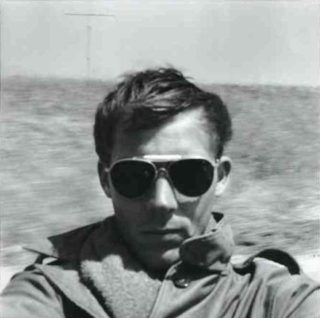 Hunter Stockton Thompson was born in Louisville, Kentucky, on July 18, 1937. His father, Jack, was a World War I veteran and insurance agent who died while Thompson was in high school, and his mother, Virginia, was an alcoholic left penniless and in charge of their charming but incorrigible son and his two younger brothers. Frequently involved in mischief, Thompson ran with a group of friends that were constantly testing the limits. At the same time, he was also developing a deep love of writing, and his talent was such that, while still in high school, he was accepted into the venerable Athenaeum Literary Association, an organization whose membership was mostly comprised of the children of well-to-do families.
Hunter Stockton Thompson was born in Louisville, Kentucky, on July 18, 1937. His father, Jack, was a World War I veteran and insurance agent who died while Thompson was in high school, and his mother, Virginia, was an alcoholic left penniless and in charge of their charming but incorrigible son and his two younger brothers. Frequently involved in mischief, Thompson ran with a group of friends that were constantly testing the limits. At the same time, he was also developing a deep love of writing, and his talent was such that, while still in high school, he was accepted into the venerable Athenaeum Literary Association, an organization whose membership was mostly comprised of the children of well-to-do families.
But Thompson was not to be contained, and his contributions to the group’s newsletter were typically sarcastic and incendiary. While honing his literary craft, Thompson simultaneously built upon his reputation as a hooligan and prankster as well, escalating his extracurricular activities from more harmless endeavors, such as dumping a truckload of pumpkins in front of a hotel, to shoplifting, vandalism and, eventually, robbery. It was during this time that he also developed what would become a lifelong fascination with firearms and a taste for drugs and alcohol.
By his senior year, Thompson found himself squarely on the wrong side of the law and was arrested several times. His misdeeds soon led to his ejection from the literary group and also earned him a few weeks in jail. Hoping to cure him of his wicked ways, the judge in his robbery case offered him the choice between prison or the military. Thompson chose the latter, and in 1956 joined the United States Air Force.
After completing his basic training, Thompson was stationed at Eglin Air Force Base in Florida, where he coped with the rigid environment by working as a sports editor for the Command Courier. However, a handful for even the toughest commanding officers, he received an early discharge in 1958, and though his military career was at an end, a legendary future in journalism awaited him.
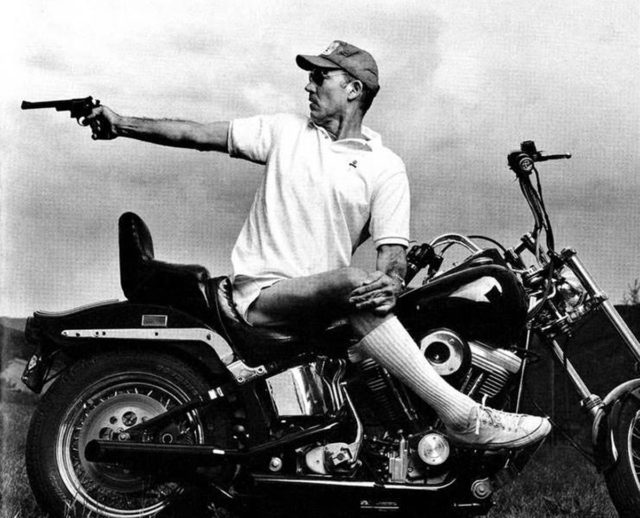 For the next few years, Thompson bounced around the country, working for a string of small-town newspapers and spending a short stint as a copy boy for Time magazine. He also spent a brief period in Puerto Rico, where he worked for a sports magazine. In his spare time, Thompson worked on more personal writing projects as well, including the autobiographical novel The Rum Diary. Rejected by publishers at that time and for decades to come, it would eventually see the light of day in 1998.
For the next few years, Thompson bounced around the country, working for a string of small-town newspapers and spending a short stint as a copy boy for Time magazine. He also spent a brief period in Puerto Rico, where he worked for a sports magazine. In his spare time, Thompson worked on more personal writing projects as well, including the autobiographical novel The Rum Diary. Rejected by publishers at that time and for decades to come, it would eventually see the light of day in 1998.
Though Thompson’s wild ways frequently cost him his job, they also endeared him to the counterculture that was gaining strength around the country at that time and helped establish him as a fearless journalist with a unique voice.
In 1971 Thompson received an assignment from Sports Illustrated to cover the Mint 400 motorcycle race in the desert outside of Vegas: they wanted about 250 words to serve as captions for photographs of the event. Thompson showed up, then promptly retired to a hotel room to bang out a 2500 word “…substance-soaked, out-of-control tale about his alter ego, Raoul Duke, and his lawyer, Dr. Gonzo (Thompson’s friend Oscar Acosta) traveling around Las Vegas in search of the American Dream.”
The first draft was reportedly composed “…by hand on Mint Hotel stationary during an all-night drink / drug frenzy while I waited for dawn to come up so I could flee without paying.”
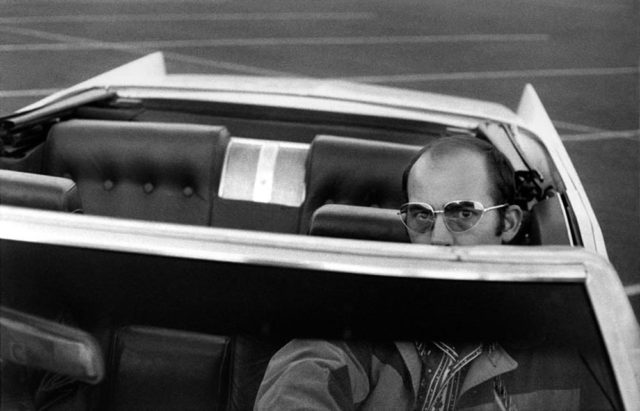 “It was almost noon, and we still had more than 100 miles to go. They would be tough miles. Very soon, I knew, we would both be completely twisted. But there was no going back, and no time to rest. We would have to ride it out. Press registration for the fabulous Mint 400 was already underway, and we had to get there by four to claim our soundproof suite. A fashionable sporting magazine in New York had taken care of the reservations, along with this huge red Chevy convertible we’d just rented off a lot on the Sunset Strip … and I was, after all, a professional journalist; so I had an obligation to cover the story, for good or ill…”
“It was almost noon, and we still had more than 100 miles to go. They would be tough miles. Very soon, I knew, we would both be completely twisted. But there was no going back, and no time to rest. We would have to ride it out. Press registration for the fabulous Mint 400 was already underway, and we had to get there by four to claim our soundproof suite. A fashionable sporting magazine in New York had taken care of the reservations, along with this huge red Chevy convertible we’d just rented off a lot on the Sunset Strip … and I was, after all, a professional journalist; so I had an obligation to cover the story, for good or ill…”
“Great God! What! What is this terrible music? “The Battle Hymn of Lieutenant Calley”:
“… as we go marching on …
When I reach my final
campground, in that land beyond the sun,
and the Great Commander
asks me …”
(What did he ask you, Rusty?)
“… Did you fight or did you run?”
(and what did you tell him, Rusty?)
“… We responded to their rifle fire with everything we had …”
No! I can’t be hearing this! It must be the drug. I glanced over at my attorney, but he was staring up at the sky, and I could see that his brain had gone off to that campground beyond the sun. Thank Christ he can’t hear this music, I thought. It would drive him into a racist frenzy.
Mercifully, the song ended. But my mood was already shattered … and now the fiendish cactus juice took over, plunging me into a sub-human funk as we suddenly came up on the turnoff to the Mint Gun Club. “One mile,” the sign said. But even a mile away I could hear the crackling scream of two-stroke bike engines winding out … and then, coming closer, I heard another sound.
Shotguns! No mistaking that flat hollow boom.
I stopped the car. What the hell is going on down there? I rolled up all the windows and eased down the gravel road, hunched low on the wheel … until I saw about a dozen figures pointing shotguns into the air, firing at regular intervals.
Standing on a slab of concrete out here in the mesquite-desert, this scraggly little oasis in a wasteland north of Vegas … They were clustered, with their shotguns, about 50 yards away from a one-story concrete/block-house, half-shaded by ten or 12 trees and surrounded by cop-cars, bike-trailers and motorcycles.
Of course. The Mint Gun Club! These lunatics weren’t letting anything interfere with their target practice. Here were about a hundred bikers, mechanics and assorted motorsport types milling around in the pit area, signing in for tomorrow’s race, idly sipping beers and appraising each other’s machinery – and right in the middle of all this, oblivious to everything but the clay pigeons flipping out of the traps every five seconds or so, the shotgun people never missed a beat.
Well, why not? I thought. The shooting provided a certain rhythm – sort of a steady bass-line – to the high-pitched chaos of the bike scene. I parked the car and wandered into the crowd, leaving my attorney in his coma.
I bought a beer and watched the bikes checking in. Many 405 Husquavarnas, high-tuned Swedish fireballs … also many Yamahas, Kawasakis, a few 500 Triumphs, Maicos, here & there a CZ, a Pursang … all very fast, super-light dirt bikes. No Hogs in this league, not even a Sportster … that would be like entering our Great Red Shark in the dune buggy competition.
Maybe I should do that, I thought. Sign my attorney up as the driver, then send him out to the starting line with a head full of ether and acid. How would they handle it?
Nobody would dare go out on the track with a person that crazy. He would roll on the first turn, and take out four or five dune buggies – a Kamikaze trip.
“What’s the entry fee?” I asked the desk-man.
“Two fifty,” he said.
“What if I told you I had a Vincent Black Shadow?”
He stared up at me, saying nothing, not friendly. I noticed he was wearing a .38 revolver on his belt. “Forget it,” I said. “My driver’s sick, anyway.”
His eyes narrowed. “Your driver ain’t the only one sick around here, buddy.”
“He has a bone in his throat,” I said.
“What?”
The man was getting ugly, but suddenly his eyes switched away. He was staring at something else … my attorney; no longer wearing his Danish sunglasses, no longer wearing his Acapulco shirt … a very crazy looking person, half-naked and breathing heavily.
“What’s the trouble here?” he croaked. “This man is my client. Are you prepared to go to court?”
I grabbed his shoulder and gently spun him around. “Never mind,” I said. “It’s the Black Shadow – they won’t accept it.”
“Wait a minute!” he shouted. “What do you mean, they won’t accept it? Have you made a deal with these pigs?”
“Certainly not,” I said, pushing him along toward the gate. “But you notice they’re all armed. We’re the only people here without guns. Can’t you hear that shooting over there.”
He paused, listened for an instant, then suddenly began running toward the car. “You cocksuckers!” he screamed over his shoulder. “We’ll be back!”
By the time we got the shark back on the highway he was able to talk. “Jesus christ! How did we get mixed up with that gang of psychotic bigots? Let’s get the fuck out of this town. Those scumbags were trying to kill us!”
* * *
The racers were ready at dawn. Fine sunrise over the desert. Very tense. But the race didn’t start until nine, so we had to kill about three long hours in the casino next to the pits, and that’s where the trouble started.
The bar opened at 7:00. There was also a “koffee & donut canteen” in the bunker, but those of us who had been up all night in places like the Circus-Circus were in no mood for coffee & donuts. We wanted strong drink. Our tempers were ugly and there were at least two hundred of us, so they opened the bar early. By 8:30 there were big crowds around the crap-tables. The place was full of noise and drunken shouting.
A boney, middle-aged hoodlum wear-a Harley-Davidson T-shirt boomed up to the bar and yelled: “God damn! What day is this – Saturday?”
“More like Sunday,” somebody replied.
“Hah! That’s a bitch, ain’t it?” the H-D boomer shouted to nobody in particular. “Last night I was out home in Long Beach and somebody said they were runnin’ the Mint 400 today, so I says to my old lady, ‘Man, I’m goin’.” He laughed. “So she gives me a lot of crap about it, you know … so I started slappin’ her around and the next thing I knew two guys I never even seen before got me out on the sidewalk workin’ me over. Jesus! They beat me stupid.”
He laughed again, talking into the crowd and not seeming to care who listened. “Hell yes!” he continued. “Then one of ’em says, ‘Where you going?’ And I says, ‘Las Vegas, to the Mint 400.’ So they gave me ten bucks and drove me down to the bus station. …” He paused. “At least I think it was them. …
“Well; anyway, here I am. And I tell you that was one hell of a long night, man! Seven hours on that goddamn bus! But when I woke up it was dawn and here I was in downtown Vegas and for a minute I didn’t know what the hell I was doin’ here. All I could think was, ‘O Jesus, here we go again: Who’s divorced me this time?'”
He accepted a cigarette from somebody in the crowd, still grinning as he lit up. “But then I remembered, by God! I was here for the Mint 400 … and, man, that’s all I needed to know. I tell you it’s wonderful to be here, man. I don’t give a damn who wins or loses. It’s just wonderful to be here with you people. …”
Nobody argued with him. We all understood. In some circles, the “Mint 400” is a far, far better thing than the Super Bowl, the Kentucky Derby and the Lower Oakland Roller Derby Finals all rolled into one. This race attracts a very special breed, and our man in the Harley T-shirt was clearly one of them.
* * *
The correspondent from Life nodded sympathetically and screamed at the bartender: “Senzaman wazzyneeds!”
“Fast up with it,” I croaked. “Why not five?” I smacked the bar with my open, bleeding palm. “Hell yes! Bring us ten!”
“I’ll back it!” The Life man screamed. He was losing his grip on the bar, sinking slowly to his knees, but still speaking with definite authority: “This is a magic moment in sport! It may never come again!” Then his voice seemed to break. “I once did the Triple Crown,” he muttered. “But it was nothing like this.”
The frog-eyed woman clawed feverishly at his belt. “Stand up!” she pleaded. “Please stand up! You’d be a very handsome man if you’d just stand up!”
He laughed distractedly. “Listen, madam,” he snapped. “I’m damn near intolerably handsome down here where I am. You’d go crazy if I stood up!”
The woman kept pulling at him. She’d been mooning at his elbows for two hours, and now she was making her move. The man from Life wanted no part of it; he slumped deeper into his crouch.
I turned away. It was too horrible. We were, after all, the absolute cream of the national sporting press. And we were gathered here in Las Vegas for a very special assignment: to cover the Fourth Annual “Mint 400” … and when it comes to things like this, you don’t fool around.
* * *
But now – even before the spectacle got under way – there were signs that we might be losing control of the situation. Here we were on this fine Nevada morning, this cool bright dawn on the desert, hunkered down at some greasy bar in a concrete blockhouse & gambling casino called the “Mint Gun Club” about ten miles out of Vegas … and with the race about to start, we were dangerously disorganized.
Outside, the lunatics were playing with their motorcycles, taping the headlights, topping off oil in the forks, last minute bolt-tightening (carburetor screws, manifold nuts, etc.) … and the first ten bikes blasted off on the stroke of nine. It was extremely exciting and we all went outside to watch. The flag went down and these ten poor buggers popped their clutches and zoomed into the first turn, all together, then somebody grabbed the lead (a 405 Husquavarna, as I recall), and a cheer went up as the rider screwed it on and disappeared in a cloud of dust.
“Well, that’s that,” somebody said. “They’ll be back around in an hour or so. Let’s go back to the bar.”
* * *
But not yet. No. There were something like a hundred and ninety more bikes waiting to start. They went off ten at a time, every two minutes. At first it was possible to watch them out to a distance of some 200 yards from the starting line. But this visibility didn’t last long. The third brace of ten disappeared into the dust about 100 yards from where we stood … and by the time they’d sent off the first 100 (with still another hundred to go), our visibility was down to something like 50 feet. We could see as far as the hay-bales at the end of the pits.
Beyond that point the incredible dust-cloud that would hang over this part of the desert for the next two days was already formed up solid. None of us realized, at the time, that this was the last we would see of the “Fabulous Mint 400” –
By noon it was hard to see the pit area from the bar/casino, 100 feet away in the blazing sun. The idea of trying to “cover this race” in any conventional press-sense was absurd: It was like trying to keep track of a swimming meet in an Olympic – sized pool filled with talcum powder instead of water. The Ford Motor Company had come through, as promised, with a “press Bronco” and a driver, but after a few savage runs across the desert – looking for motorcycles and occasionally finding one – I abandoned this vehicle to the photographers and went back to the bar.
It was time, I felt, for an Agonizing Reappraisal of the whole scene. The race was definitely underway. I had witnessed the start; I was sure of that much. But what now? Rent a helicopter? Get back in that stinking Bronco? Wander out on that goddamn desert and watch these fools race past the checkpoints? One every 13 minutes. …?
By ten they were spread out all over the course. It was no longer a “race”; now it was an Endurance Contest. The only visible action was at the start/finish line, where every few minutes some geek would come speeding out of the dust-cloud and stagger off his bike, while his pit crew would gas it up and then launch it back onto the track with a fresh driver … for another 50-mile lap, another brutal hour of kidney-killing madness out there in that terrible dust-blind limbo.
Somewhere around 11, I made another tour in the press-vehicle, but all we found were two dune-buggies full of what looked like retired petty-officers from San Diego. They cut us off in a dry-wash and demanded, “Where is the damn thing?”
“Beats me,” I said. “We’re just good patriotic Americans like yourselves.” Both of their buggies were covered with ominous symbols: Screaming Eagles carrying American Flags in their claws, a slant-eyed snake being chopped to bits by a buzz-saw made of stars & stripes, and one of the vehicles had what looked like a machine-gun mount on the passenger side.
They were having a bang-up time – just crashing around the desert at top speed and hassling anybody they met. “What outfit you fellas with?” one of them shouted. The engines were all roaring; we could barely hear each other.
“The sporting press,” I yelled. “We’re friendlies – hired geeks.”
Dim smiles.
“If you want a good chase,” I shouted “you should get after that skunk from CBS News up ahead in the big black jeep. He’s the man responsible for The Selling of the Pentagon.”
“Hot damn!” two of them screamed at once. “A black jeep? You say?”
They roared off, and so did we. Bouncing across the rocks & scrub oak/cactus like iron tumbleweeds. The beer in my hand flew up and hit the top, then fell in my lap and soaked my crotch with warm foam.
“You’re fired,” I said to the driver. “Take me back to the pits.”
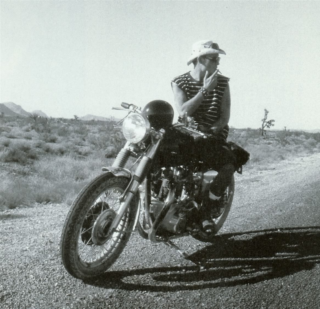 It was time, I felt, to get grounded – to ponder this rotten assignment and figure out how to cope with it. Lacerda insisted on Total Coverage. He wanted to go back out in the dust storm and keep trying for some rare combination of film and lens that might penetrate the awful stuff.
It was time, I felt, to get grounded – to ponder this rotten assignment and figure out how to cope with it. Lacerda insisted on Total Coverage. He wanted to go back out in the dust storm and keep trying for some rare combination of film and lens that might penetrate the awful stuff.
“Joe,” our driver, was willing. His name was not really “Joe,” but that’s what we’d been instructed to call him. I had talked to the FoMoCo boss the night before, and when he mentioned the driver he was assigning to us he said, “His real name is Steve, but you should call him Joe.”
“Why not?” I said. “We’ll call him anything he wants. How about ‘Zoom’?”
“No dice,” said the Ford man. “It has to be ‘Joe.'”
Lacerda agreed, and sometime around noon he went out on the desert, again, in the company of our driver, Joe. I went back to the blockhouse bar/casino that was actually the Mint Gun Club – where I began to drink heavily, think heavily, and make many heavy notes…”
–Rolling Stone Magazine, Fear and Loathing in Las Vegas By Hunter S. Thompson; ,
Soundly rejected by Sports Illustrated, the story appeared in a serialized format in Rolling Stone that November and was later expanded upon to become what is arguably Thompson’s best-known work, the 1972 book Fear and Loathing in Las Vegas: A Savage Journey to the Heart of the American Dream.
Hunter S. Thompson’s campaign video for Sheriff of Piktin County, Colorado in 1970.
Hunter had bought a compound on the outskirts of Aspen, Colorado with the proceeds from Hell’s Angels, which he named Owl Creek. He moved there with his wife, Sandy Conklin and their son, Juan in 1967.
In 1970 he decided to shake up the local establishment by running for sheriff of Pitkin County, Colorado on the “Freak Power” ticket. With a platform that included relaxing penalties for drug offenses, renaming Aspen “Fat City” and replacing the the streets with sod, Thompson was only narrowly defeated by his mainstream opponent. His story about the campaign, “The Battle of Aspen,” appeared in Rolling Stone that October.
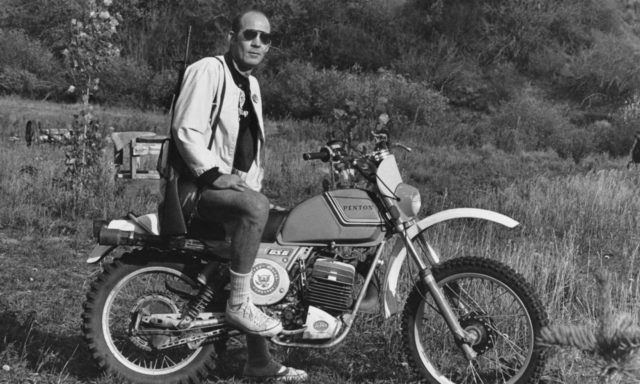 In “Stories I Tell Myself: Growing up with Hunter S. Thompson” Hunter’s son Juan F. Thompson recalls; “Sometimes Hunter would crank up his Bultaco Matador trail motorcycle, I would climb on the back and hang on to him as tightly as I could, and we would race down the street… We never talked about it, it was just a quick motorcycle ride, but it was also a private adventure just between us. We didn’t have that many of them, so those memories are precious.”
In “Stories I Tell Myself: Growing up with Hunter S. Thompson” Hunter’s son Juan F. Thompson recalls; “Sometimes Hunter would crank up his Bultaco Matador trail motorcycle, I would climb on the back and hang on to him as tightly as I could, and we would race down the street… We never talked about it, it was just a quick motorcycle ride, but it was also a private adventure just between us. We didn’t have that many of them, so those memories are precious.”
Thompson once described the Bultaco in a letter as “a lightweight Spanish bugger, built for dirt-riding instead of freeways”. It was ideal for one of his favorite pastimes: trespassing through the fields of his Colorado neighbors, carrying wire-cutters and at least one pistol.
In 1972 Thompson set out to cover the presidential campaigns of Richard Nixon and George McGovern. Appearing initially as a series of articles in Rolling Stone, Thompson’s incendiary and humorous accounts were later collected and published as Fear and Loathing on the Campaign Trail ’72. But the hard-driving lifestyle began to take its toll; sent to Zaire in 1974 to cover the famous “Rumble in the Jungle” boxing match between George Foreman and Muhammad Ali, Thompson skipped the fight and instead spent his time floating in the hotel pool, into which he had tossed a pound and a half of marijuana. The article never materialized, nor did many other of Thompson’s projects in the coming years that were begun in earnest only to be abandoned later. In 1980, his wife, Sandy, divorced him.
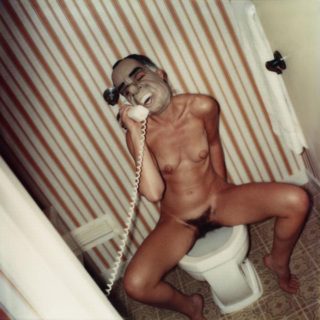 “After Miami the calendar shows a bit of rest on the political front — but not for me: I have to come back out to California and ride that goddamn fiendish Vincent Black Shadow again, for the road tests. The original plan was to deal with the beast in my off-hours during the California primary coverage, but serious problems developed.
“After Miami the calendar shows a bit of rest on the political front — but not for me: I have to come back out to California and ride that goddamn fiendish Vincent Black Shadow again, for the road tests. The original plan was to deal with the beast in my off-hours during the California primary coverage, but serious problems developed.
Ten days before the election — with McGovern apparently so far ahead that most of the press people were looking for ways to avoid covering the final week — I drove out to Ventura, a satellite town just north of L.A. in the San Fernando Valley, to pick up the bugger and use it to cover the rest of the primary. Greg Jackson, an ABC correspondent who used to race motorcycles, went along with me. We were both curious about this machine. Chris Bunche, editor of Choppers magazine, said it was so fast and terrible that it made the extremely fast Honda 750 seem like a harmless toy.
This proved to be absolutely true. I rode a factory-demo Honda for a while, just to get the feel of being back on a serious road-runner again . . . and it seemed just fine: very quick, very powerful, very easy in the hands, one-touch electric starter. A very civilized machine, in all, and I might even be tempted to buy one if I didn’t have the same gut distaste for Hondas that the American Honda management has for Rolling Stone. They don’t like the image. “You meet the nicest people on a Honda,” they say — but according to a letter from American Honda to the Rolling Stone ad manager, none of these nicest people have much stomach for a magazine like the Stone.
Which is probably just as well; because if you’re a safe, happy, nice, young Republican you probably don’t want to read about things like dope, rock music and politics anyway. You want to stick with Time, and for weekend recreation do a bit of the laid-back street-cruising on your big fast Honda 750. . . maybe burn a Sportster or a Triumph here or there, just for the fun of it: But nothing serious, because when you start that kind of thing you don’t meet many nice people.
Jesus! Another tangent, and right up front, this time — the whole lead, in fact, completely fucked.”
————————-
“But first things first. We were talking about motorcycles. Jackson and I were out there in Ventura fucking around with a 750 Honda and an experimental prototype of the new Vincent — a 1000-cc brute that proved to be so awesomely fast that I didn’t even have time to get scared of it before I found myself coming up on a highway stoplight at ninety miles an hour and then skidding halfway through the intersection with both wheel-brakes locked.
A genuinely hellish bike. Second gear peaks around 65 — cruising speed on the freeways — and third winds out somewhere between 95 and 100. I never got to fourth, which takes you up to 120 or so — and after that you shift into fifth.
Top speed is 140, more or less, depending on how the thing is tuned — but there is nowhere in Los Angeles County to run a bike like that. I managed to get it back from Ventura to McGovern’s downtown headquarters hotel, staying mainly in second gear, but the vibration almost fused my wrist bones and boiling oil from the breather pipes turned my right foot completely black. Later, when I tried to start it up for another test-run, the backlash from the kick-starter almost broke my leg. For two days afterward I limped around with a golfball-sized blood-bruise in my right arch.
Later in the week I tried the bastard again, but it stalled on a ramp leading up to the Hollywood Freeway and I almost broke my hand when I exploded in a stupid, screaming rage and punched the gas tank. After that I locked it up and left it in the hotel parking lot — where it sat for many days with a MCGOVERN FOR PRESIDENT tag on the handlebars.
George never mentioned it, and when I suggested to Gary Hart that the Senator might like to take the machine out for a quick test-ride and some photos for the national press, I got almost exactly the same reaction that Mankiewicz laid on me in Florida when I suggested that McGovern could pick up a million or so votes by inviting the wire-service photographers to come out and snap him lounging around on the beach with a can of beer in his hand and wearing my Grateful Dead T-shirt.”
Fear and Loathing: On the Campaign Trail ’72 (1973)- Hunter S. Thompson
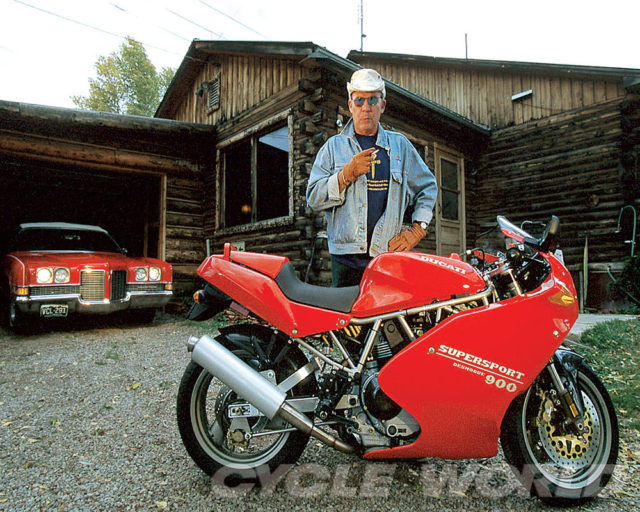 In 1995 Cycle World feature editor Brenda Buttner asked Thompson to review the Ducati 900 SuperSport. In a 2012 article she recalled:
In 1995 Cycle World feature editor Brenda Buttner asked Thompson to review the Ducati 900 SuperSport. In a 2012 article she recalled:
“As Feature Editor of Cycle World, I displayed either the idiocy or insight to give Hunter S. Thompson a high-end, high-speed, high-priced Ducati and did so with no guarantee that the Guru of Gonzo would return either the motorcycle or an article….Trouble was, that idea started out as a dare, and I almost always fall prey to such provocations. So when my boss, still appropriately pissed off that I dropped an expensive testbike while making what should have been a simple spin down a driveway, challenged that Hunter S. Thompson’s byline was a prize he’d love but doubted I could deliver, I took the bait with a big gulp and tore that “Memo to Me” into the confetti that could have marked my march out of the job I loved. Risky? No question. But Thompson himself would be quick to agree that you have to take risks to get anything worthwhile, and that hard-drinking, rough-talking iconoclast delivered intoxicating prose more potent than a straight shot of his favorite Wild Turkey. Two days later, off went a letter addressed to Hunter S. Thompson, The Owl Farm, Aspen, Colorado, offering the use of a Ducati SuperSport for a month, along with the invitation to write about his experience in any way he wished.
“Send bike immediately.” A single sentence typed on a classic Royal. No mention that the Duc was not a gift but on loan; no word about any article. But armed now with his phone number, I called.
“You sound crazy,” he mumbled, his voice growling like the sound of tires spitting loose gravel in a tight turn. “Crazy.”
I figured I had him then. Crazy, after all, is a compliment from this expert of extremes, perhaps even high praise from the Prince of Wild and Weird whose best-selling tales of pushing the envelope made him a household name, not to mention a character in the cartoon strip, “Doonesbury.” A week later, I arrived in Aspen on a Honda VFR750, braving an early fall snowstorm on my long journey to Hunter’s hangout. Two metal vultures, riddled with bullet holes, greeted me, as did a sign on the front door of a weathered log cabin warning away visitors with a photo of the wrong end of a rifle. (Likely not an idle threat to trespassers—Hunter had quite the fondness for firearms.) But there was no turning back now. And besides, the late afternoon was perfect for a ride. Hints of Indian summer crackled in the air, splashes of sunshine so brilliant they overshadowed even the purple-breasted peacocks that Hunter kept as pets. My Honda and the SuperSport parked next to it begged to get on the road.
He is no stranger to motorcycles—at least one had graced his garage since he bought a BSA 650 in the late ’60s. An old BMW was there when I visited. But this would be his first spin aboard the rocket ride that is a Ducati, and he took care to do more than merely admire its elegant European lines. He scrutinized the engine intently and asked many questions, especially about the turning radius. “You don’t want to make a dumb mistake,” he advised. “Crazy mistakes are okay, but forget the dumb ones.”
My mistake was in turning away for a moment. With a thunderous boom, the bike burst down the driveway, and before I could jump on my Honda, he was a blur of crimson in the distance.”
“There are some things nobody needs in this world, and a bright-red, hunch-back, warp-speed 900cc cafe racer is one of them – but I want one anyway, and on some days I actually believe I need one. That is why they are dangerous.
Everybody has fast motorcycles these days. Some people go 150 miles an hour on two-lane blacktop roads, but not often. There are too many oncoming trucks and too many radar cops and too many stupid animals in the way. You have to be a little crazy to ride these super-torque high-speed crotch rockets anywhere except a racetrack – and even there, they will scare the whimpering shit out of you… There is, after all, not a pig’s eye worth of difference between going head-on into a Peterbilt or sideways into the bleachers. On some days you get what you want, and on others, you get what you need.
When Cycle World called me to ask if I would road-test the new Harley Road King, I got uppity and said I’d rather have a Ducati superbike. It seemed like a chic decision at the time, and my friends on the superbike circuit got very excited. “Hot damn,” they said. “We will take it to the track and blow the bastards away.”
“Balls,” I said. “Never mind the track. The track is for punks. We are Road People. We are Cafe Racers.”
The Cafe Racer is a different breed, and we have our own situations. Pure speed in sixth gear on a 5000-foot straightaway is one thing, but pure speed in third gear on a gravel-strewn downhill s-turn is quite another.
But we like it. A thoroughbred Cafe Racer will ride all night through a fog storm in freeway traffic to put himself into what somebody told him was the ugliest and tightest decreasing-radius turn since Genghis Khan invented the corkscrew.
Cafe Racing is mainly a matter of taste. It is an atavistic mentality, a peculiar mix of low style, high speed, pure dumbness, and overweening commitment to the Cafe Life and all its dangerous pleasures… I am a Cafe Racer myself, on some days – and it is one of my finest addictions.
I am not without scars on my brain and my body, but I can live with them. I still feel a shudder in my spine every time I see a picture of a Vincent Black Shadow, or when I walk into a public restroom and hear crippled men whispering about the terrifying Kawasaki Triple… I have visions of compound femur-fractures and large black men in white hospital suits holding me down on a gurney while a nurse called “Bess” sews the flaps of my scalp together with a stitching drill.
Ho, ho. Thank God for these flashbacks. The brain is such a wonderful instrument (until God sinks his teeth into it). Some people hear Tiny Tim singing when they go under, and some others hear the song of the Sausage Creature.
When the Ducati turned up in my driveway, nobody knew what to do with it. I was in New York, covering a polo tournament, and people had threatened my life. My lawyer said I should give myself up and enroll in the Federal Witness Protection Program. Other people said it had something to do with the polo crowd.
The motorcycle business was the last straw. It had to be the work of my enemies, or people who wanted to hurt me. It was the vilest kind of bait, and they knew I would go for it.
Of course. You want to cripple the bastard? Send him a 130-mph cafe-racer. And include some license plates, he’ll think it’s a streetbike. He’s queer for anything fast.
Which is true. I have been a connoisseur of fast motorcycles all my life. I bought a brand-new 650 BSA Lightning when it was billed as “the fastest motorcycle ever tested by Hot Rod magazine.” I have ridden a 500-pound Vincent through traffic on the Ventura Freeway with burning oil on my legs and run the Kawa 750 Triple through Beverly Hills at night with a head full of acid… I have ridden with Sonny Barger and smoked weed in biker bars with Jack Nicholson, Grace Slick, Ron Zigler and my infamous old friend, Ken Kesey, a legendary Cafe Racer.
Some people will tell you that slow is good – and it may be, on some days – but I am here to tell you that fast is better. I’ve always believed this, in spite of the trouble it’s caused me. Being shot out of a cannon will always be better than being squeezed out of a tube. That is why God made fast motorcycles, Bubba….
So when I got back from New York and found a fiery red rocket-style bike in my garage, I realized I was back in the road-testing business.
The brand-new Ducati 900 Campione del Mundo Desmodue Supersport double-barreled magnum Cafe Racer filled me with feelings of lust every time I looked at it. Others felt the same way. My garage quickly became a magnet for drooling superbike groupies. They quarreled and bitched at each other about who would be the first to help me evaluate my new toy… And I did, of course, need a certain spectrum of opinions, besides my own, to properly judge this motorcycle. The Woody Creek Perverse Environmental Testing Facility is a long way from Daytona or even top-fuel challenge-sprints on the Pacific Coast Highway, where teams of big-bore Kawasakis and Yamahas are said to race head-on against each other in death-defying games of “chicken” at 100 miles an hour….
No. Not everybody who buys a high-dollar torque-brute yearns to go out in a ball of fire on a public street in L.A. Some of us are decent people who want to stay out of the emergency room, but still blast through neo-gridlock traffic in residential districts whenever we feel like it… For that we need Fine Machinery.
Which we had – no doubt about that. The Ducati people in New Jersey had opted, for some reasons of their own, to send me the 900ss-sp for testing – rather than their 916 crazy-fast, state-of-the-art superbike track-racer. It was far too fast, they said – and prohibitively expensive – to farm out for testing to a gang of half-mad Colorado cowboys who think they’re world-class Cafe Racers.
The Ducati 900 is a finely engineered machine. My neighbors called it beautiful and admired its racing lines. The nasty little bugger looked like it was going 90 miles an hour when it was standing still in my garage.
Taking it on the road, though, was a genuinely terrifying experience. I had no sense of speed until I was going 90 and coming up fast on a bunch of pickup trucks going into a wet curve along the river. I went for both brakes, but only the front one worked, and I almost went end over end. I was out of control staring at the tailpipe of a U.S. Mail truck, still stabbing frantically at my rear brake pedal, which I just couldn’t find… I am too tall for these new-age roadracers; they are not built for any rider taller than five-nine, and the rearset brake pedal was not where I thought it would be. Mid-size Italian pimps who like to race from one cafe to another on the boulevards of Rome in a flat-line prone position might like this, but I do not.
I was hunched over the tank like a person diving into a pool that got emptied yesterday. Whacko! Bashed on the concrete bottom, flesh ripped off, a Sausage Creature with no teeth, fucked-up for the rest of its life.
We all love Torque, and some of us have taken it straight over the high side from time to time – and there is always Pain in that… But there is also Fun, the deadly element, and Fun is what you get when you screw this monster on. BOOM! Instant take-off, no screeching or squawking around like a fool with your teeth clamping down on our tongue and your mind completely empty of everything but fear.
No. This bugger digs right in and shoots you straight down the pipe, for good or ill.
On my first take-off, I hit second gear and went through the speed limit on a two-lane blacktop highway full of ranch traffic. By the time I went up to third, I was going 75 and the tach was barely above 4000 rpm….
And that’s when it got its second wind. From 4000 to 6000 in third will take you from 75 mph to 95 in two seconds – and after that, Bubba, you still have fourth, fifth, and sixth. Ho, ho.
I never got to sixth gear, and I didn’t get deep into fifth. This is a shameful admission for a full-bore Cafe Racer, but let me tell you something, old sport: This motorcycle is simply too goddamn fast to ride at speed in any kind of normal road traffic unless you’re ready to go straight down the centerline with your nuts on fire and a silent scream in your throat.
When aimed in the right direction at high speed, though, it has unnatural capabilities. This I unwittingly discovered as I made my approach to a sharp turn across some railroad tracks, saw that I was going way too fast and that my only chance was to veer right and screw it on totally, in a desperate attempt to leapfrog the curve by going airborne.
It was a bold and reckless move, but it was necessary. And it worked: I felt like Evel Knievel as I soared across the tracks with the rain in my eyes and my jaws clamped together in fear. I tried to spit down on the tracks as I passed them, but my mouth was too dry… I landed hard on the edge of the road and lost my grip for a moment as the Ducati began fishtailing crazily into oncoming traffic. For two or three seconds I came face to face with the Sausage Creature….
But somehow the brute straightened out. I passed a schoolbus on the right and got the bike under control long enough to gear down and pull off into an abandoned gravel driveway where I stopped and turned off the engine. My hands had seized up like claws and the rest of my body was numb. I felt nauseous and I cried for my mama, but nobody heard, then I went into a trance for 30 or 40 seconds until I was finally able to light a cigarette and calm down enough to ride home. I was too hysterical to shift gears, so I went the whole way in first at 40 miles an hour.
Whoops! What am I saying? Tall stories, ho, ho… We are motorcycle people; we walk tall and we laugh at whatever’s funny. We shit on the chests of the Weird….
But when we ride very fast motorcycles, we ride with immaculate sanity. We might abuse a substance here and there, but only when it’s right. The final measure of any rider’s skill is the inverse ratio of his preferred Traveling Speed to the number of bad scars on his body. It is that simple: If you ride fast and crash, you are a bad rider. And if you are a bad rider, you should not ride motorcycles.
The emergence of the superbike has heightened this equation drastically. Motorcycle technology has made such a great leap forward. Take the Ducati. You want optimum cruising speed on this bugger? Try 90mph in fifth at 5500 rpm – and just then, you see a bull moose in the middle of the road. WHACKO. Meet the Sausage Creature.
Or maybe not: The Ducati 900 is so finely engineered and balanced and torqued that you *can* do 90 mph in fifth through a 35-mph zone and get away with it. The bike is not just fast – it is *extremely* quick and responsive, and it *will* do amazing things… It is like riding a Vincent Black Shadow, which would outrun an F-86 jet fighter on the take-off runway, but at the end, the F-86 would go airborne and the Vincent would not, and there was no point in trying to turn it. WHAMO! The Sausage Creature strikes again.
There is a fundamental difference, however, between the old Vincents and the new breed of superbikes. If you rode the Black Shadow at top speed for any length of time, you would almost certainly die. That is why there are not many life members of the Vincent Black Shadow Society. The Vincent was like a bullet that went straight; the Ducati is like the magic bullet in Dallas that went sideways and hit JFK and the Governor of Texas at the same time.
It was impossible. But so was my terrifying sideways leap across the railroad tracks on the 900sp. The bike did it easily with the grace of a fleeing tomcat. The landing was so easy I remember thinking, goddamnit, if I had screwed it on a little more I could have gone a lot farther.
Maybe this is the new Cafe Racer macho. My bike is so much faster than yours that I dare you to ride it, you lame little turd. Do you have the balls to ride this BOTTOMLESS PIT OF TORQUE?
That is the attitude of the new-age superbike freak, and I am one of them. On some days they are about the most fun you can have with your clothes on. The Vincent just killed you a lot faster than a superbike will. A fool couldn’t ride the Vincent Black Shadow more than once, but a fool can ride a Ducati 900 many times, and it will always be a bloodcurdling kind of fun. That is the Curse of Speed which has plagued me all my life. I am a slave to it. On my tombstone they will carve, “IT NEVER GOT FAST ENOUGH FOR ME.”
– Hunter S. Thompson, “Song of the Sausage Creature“, Cycle World Magazine, March 1995
For the remainder of his life, Thompson continued to write, though much of his published work would be from his earlier, more productive periods. From the years 1979 to 1994, Random House released four volumes of his collected writing under the series title The Gonzo Papers, and in 2003—a year in which he remarried, to his assistant Anita Bejmuk—his semi-autobiographical rambling Kingdom of Fear was published by Simon and Schuster.
By 2005, Thompson had grown chronically depressed, disillusioned by the world around him, frustrated with aging and suffering from numerous health problems. Sick of it all, on February 20, 2005, at his Owl Creek compound, Hunter S. Thompson shot himself in the head. That August, in a private ceremony commemorating his life that was attended by hundreds of his friends and admirers, Thompson’s ashes were shot from a cannon to the tune of Bob Dylan’s “Mr. Tambourine Man.”
Maybe it finally got fast enough.
References:
The Motorcycle Gangs: A portrait of an outsider underground By Hunter S. Thompson; The Nation, May 17, 1965
Fear and Loathing in Las Vegas By Hunter S. Thompson; Rolling Stone Magazine, November 11, 1971
Going Gonzo Revisited; The most unlikely day at Owl Farm. By Brenda Buttner, Cycle World, November 21, 2012
The Electric Typewriter: 20 Great Articles by Hunter S. Thompson
HST – Rare Articles Totally Gonzo – The Hunter S. Thompson and Gonzo Journalism Community
HUNTER S. THOMPSON | HELL’S ANGELS– The Selvedge Yard
Hell’s Angels: The Strange and Terrible Saga of the Outlaw Motorcycle Gangs: Hunter S. Thompson (full text .pdf)

